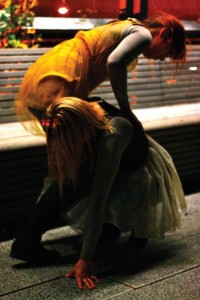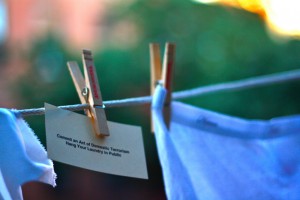A woman covered in can lids danced down 14th Street between Avenue D and First Avenue; the aluminum tops clicking and clacking connected to her clothes could be heard from a block away.

When a passerby noticed her, she would gradually move closer and dance suggestively towards them. Art in Odd Places had officially returned to New York City.
Corrine Cappelletti and three other dancers created choreography to coincide with the stories and lives of locals.
From October 1 to October 10, Art in Odd Places, in partnership with Parsons, made its seventh annual appearance in New York. The program was helmed by Victoria Marshall, Assistant Professor of Urban Design in the School of Design Strategies, Parsons School the New School for Design; Adam Brent, Assistant Professor of Fine Arts in the School of Design Strategies, Parsons School the New School for Design; and Simone Douglas, Associate Professor of Photography at Parsons School the New School for Design.
Artists exhibited a wide variety of projects, from theatrical performances to public installations. This year the theme was rituals. According to the AiOP website a ritual is, “generally defined as a series of established actions that are carried out in private or public spaces, by individuals or by groups, for their spiritual, social or political significance. By conducting such rituals, artists can engage politics, culture, religion, community and relationships into their work on an everyday basis.”
“This partnership seized on funding opportunities for a larger cross school collaboration incorporating the like learning outcomes of the School of Art Media and Technology into our School of Design Strategies based proposal.” Woodham added that the goals of AiOP include, “To be a good neighbor. To create ruptures in public space everyday routines of pedestrians, passersby, and tourists.”
In Rob Andrew’s “Union Square Clean,” models draped in black coverings stood barefoot on mats. They held instruction cards that read, “Clean these feet. Dry them. Hold then in your hands. Be silent. Pray.”
“The interactive element of ‘Union Square Clean’ made it stand out more than just a painting in a museum,” said Parsons student Paige Gilligan. “I feel that Art in Odd Places is important because it supports street art, which has been decline in New York City since many street artists have turned to galleries as a way to make money.”
 While many artworks or performances provoked interest up and down 14th Street, others caused anxiety.
While many artworks or performances provoked interest up and down 14th Street, others caused anxiety.
“Sometimes we get looks of concern or worry,” explained Corinne Cappelletti, who participated in the festival. For her piece, “Carry Your Burdens,” Cappelletti and three other dancers used a mix of choreographed and improvised dance to depict the everyday problems of individuals. Cappelletti has studied human movement extensively and is a Certified Laban Movement Analyst, a form of dance that draws on effort and shape of the movement interpret human movement.
“I talked to different people all along 14th Street. I asked what their burden was, how they overcame it to be where they are right now, and if they could let something go, what it would be,” explained Cappelletti.
As the Occupy Wall Street movement gains momentum, AiOP’s mission to use public space as a venue for art is shifting.
“I think that this festival is really important because it challenges what public space should be used for,” said Edith Raw, an artist who participated in AiOP. “I think that Occupy Wall Street is doing a similar thing when we’re living in times that are extremely oppressive. Art has been really supported in New York in the past, and I think its just a corporatization of Bloomberg’s New York that makes it a very difficult place for artists to be now. We have to put ourselves out there and fight for this space to be seen and heard.”
Artist Lois Weaver hung clotheslines all along 14th Street. His purpose was to question the line between what is public and what is private. “Its very fresh. I just love the concept of hanging laundry in public. It’s a different form of art, and not just a regular exhibit in a gallery,” said onlooker Nora Zographu.







Leave a Reply